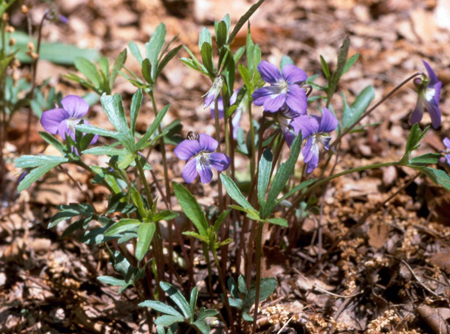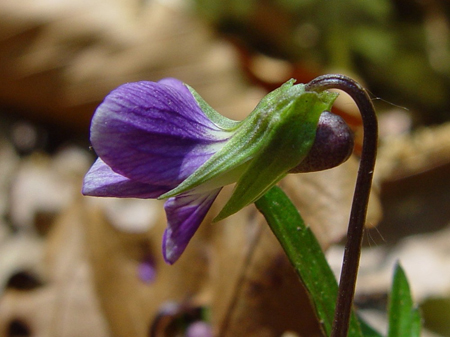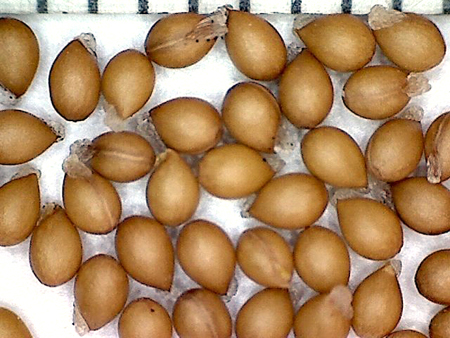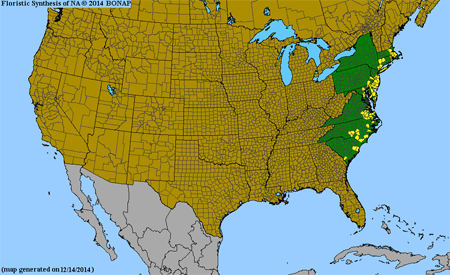Viola brittoniana Pollard
Common names:
Britton's Violet, Northern Coast Violet
Synonyms:
Viola brittoniana Pollard, in Britton, Man. fl. n. states, ed. 1: 635. 1901 [replacement name for V. atlantica]; Viola pedatifida G.Don var. brittoniana (Pollard) R.J.Little & L.E.McKinney, J. Bot. Res. Inst. Texas 4(1): 225. 2010; Viola pedatifida G.Don subsp. brittoniana (Pollard) L.E.McKinney, Sida, Bot. Misc. 7: 22. 1992; Viola atlantica Britton, Bull. Torrey Bot. Club 24: 92. 1897 [illegitimate homonym of V. atlantica Pomel (1874)]. TYPE: New York, Staten Island, along salt meadows, 8 Jun 1888, N. L. Britton s.n. (LECTOTYPE (incorrectly designated as holotype by Landon McKinney, Sida, Bot. Misc. 7: 22. 1992, corrected by Nir Gil-ad. 1997. Boissiera 53: 53): NY00095712!, isolectotype: US00479254, JSTOR Global Plants image!)
Description:
Acaulescent rosulate perennials from thick rhizome, ≤ 26 cm tall; foliage and peduncles green with lower surface of leaf blades often tinged purple, petioles and peduncles glabrous, leaf blades finely appressed-hirtellous along veins and ciliolate; stipules free, irregularly glandular-fimbriate; homophyllous, leaves ascending, smallest leaf blades palmatifid, largest deeply biternately divided into 7 or 9 lanceolate lobes, central lobe of terminal primary division commonly distinctly broader and longer than its lateral lobes, ≤ 75 × 95 mm, outline narrowly to broadly ovate, base subtruncate to cordate, margins entire proximally and usually irregularly serrulate distally, ciliolate, apex broadly acute to obtuse; chasmogamous peduncle often held among the leaves; chasmogamous flower ≤ 20 mm; calyx glabrous, eciliate or auricles infrequently irregularly ciliolate; lowest sepals linear-lanceolate to lanceolate, acuminate; auricles usually prominent and entire or erose, elongating to 3 mm in fruit; corolla blue to purple, throat white; lateral petals bearded with filiform to narrowly linear hairs, spurred petal densely bearded; cleistogamous flowers produced after chasmogamous, on erect peduncle commonly a little shorter than the petioles; capsule 9–18 mm, yellow-green drying tan, unspotted, glabrous; seeds 1.3–1.9 × 0.8–1.3 mm, medium brown to orange-brown, unspotted; 2n=54.
Similar species:
This species homophyllous cut-leaved species has been most frequently confused with other members of the Pedatifida and Subsinuata species groups. It differs from V. pedatifida in its ovate cordate biternately divided leaf blades and with other features noted in the key, sepals eciliate (but auricles sometimes ciliolate), and slightly smaller seeds. It is easily separated from V. baxteri and V. subsinuata by its glabrous petioles and peduncle, leaf blades appressed-hirtellous along veins and ciliolate along margins, lanceolate to linear-lanceolate acuminate sepals and prominent auricles, densely bearded spurred petal, unspotted cleistogamous capsule on tall erect peduncle, and unspotted brown to orange-brown seeds. Both this and V. septemloba grow along the Atlantic Coastal Plain, with almost non-overlapping local ranges, but the two have been misidentified for each other. This species differs from the heterophyllous V. septemloba in all leaf blades being divided, the largest thinner and biternately divided with the terminal lobe of the terminal primary division usually narrow, blade surfaces appressed-pubescent along veins, and ciliolate margins, the chasmogamous peduncle often held among the leaves, often smaller flower, and smaller medium brown seeds.
Ecology:
Moist to seasonally inundated sandy, peaty or mucky soils of seeps, bogs, brackish marshes, streambanks and river shores, persisting in ditches bordering fields, moist meadows, trail edges, and forest clearings.
Distribution:
Typically near the Atlantic coast in the north half of its range but shifting inland to the upper Coastal Plain and "Fall Line" in the Carolinas; MA south to SC.
Rarity:
State listed in most states in which it occurs, CT, NC, NJ, NY, and PA.
Phenology:
Chasmogamous flower April–June, chasmogamous fruit May–July, cleistogamous fruit July–August.
Affinities:
This species belongs to the Acaulescent Blue Violet lineage, sect. Nosphinium W.Becker, subsect. Boreali-Americanae (W.Becker) Gil-ad, in the Pedatifida species group.
Hybrids:
Hybridizes with V. affinis (Dowell 1910, Brainerd 1924, House 1924), V. communis or possibly V. sororia [glabrous variant] or Viola sororia [hirsutuloides variant] (Dowell 1919, Brainerd 1924, House 1924), V. cucullata (Bicknell 1904, House 1905, Brainerd 1906b, 1907a, 1924, Haines et al. 2011), V. emarginata sensu stricto (House 1906b, Brainerd 1906b, Brainerd 1924, House 1924), V. fimbriatula (Pollard 1902, Brainerd 1906b, 1907a, 1924, Dowell 1910, Haines et al. 2011), V. lanceolata (Forbes 1909, Brainerd 1924, Haines et al. 2011), V. palmata var. triloba (Brainerd 1906b, 1924), V. pectinata (Brainerd 1906b, 1924, Haines et al. 2011, Ballard pers. comm.), V. sagittata (Brainerd 1906b, 1924, House 1906b, 1924), V. sororia sensu stricto (Brainerd 1924, House 1924, Haines et al. 2011), and V. subsinuata sensu stricto (Brainerd 1906b, House 1924). Brainerd reported that the hybrids he observed exhibited intermediate or recombinant characteristics of foliage, chasmogamous flowers, cleistogamous capsules and seeds (where these did not abort), failed to reproduce by chasmogamous flowers, and produced cleistogamous capsules that were largely abortive or yielded a substantially reduced proportion of viable seeds. Individuals of V. brittoniana × V. pectinata, which we transplanted from multiple sites in NJ and NC, did not manifest significant reduction of mature cleistogamous seeds.
Comments:
Brainerd (1921b), Brainerd Baird (1942), Fernald (1950), Alexander (1963), Russell (1965), Gil-ad (1995, 1997), Ballard (2000), Haines et al. (2011), and Weakley et al. (2012) maintained V. brittoniana as a distinct species; however, McKinney (1992) subsumed it as a subspecies under V. pedatifida, and Gleason and Cronquist (1991) lumped it and several other taxa in a very broadly delimited V. palmata var. pedatifida. Little and McKinney (2015) later reinstated the present taxon to species status (synonymizing V. baxteri and V. pectinata under it). Gil-ad (1995, 1997, 1998) and Zumwalde (2015) provided compelling empirical evidence to support recognition of V. brittoniana and V. pedatifida as distinct species. The circumscription applied here excludes V. pectinata; for comments see that species. Two potentially misleading sources of information have probably contributed to the erroneous reports of V. septemloba on the Atlantic Coastal Plain north of Virginia: Brainerd's earliest misnaming of V. brittoniana as V. septemloba before he and others accepted two distinct species, and herbarium specimens of occasional hybrids between V. brittoniana and V. sagittata that crudely resemble V. septemloba.
Literature Cited:
Alexander, E. J. 1963. Violaceae. In Gleason, H. A., The new Britton and Brown illustrated flora of the northeastern United States and adjacent Canada. Hafner Publishing Co., Inc., New York, NY. 552-567.
Ballard Jr., H. E. 2000. Violaceae. In Rhoads, A. (ed.). Flora of Pennsylvania. University of Pennsylvania Press, Philadelphia, PA. 700-710.
Bicknell, E. P. 1904. Three new violets from Long Island. Torreya 4: 129-132.
Brainerd, E. 1906b. Hybridism in the genus Viola,-III. Rhodora8: 49-60, plates 66-70.
Brainerd, E. 1907a. The behavior of the seedlings of certain Viola hybrids. Science 25: 940-944.
Brainerd, E. 1921b. Violets of North America. Vermont Agricultural Experiment Station Bulletin 224: 1–172.
Brainerd, E. 1924. The natural violet hybrids of North America. Vermont Agricultural Experiment Station Bulletin 239: 1-205.
Brainerd Baird, V. 1942. Wild violets of North America. University of California Press, Berkeley, CA.
Dowell, P. 1910. The violets of Staten Island. Bull. Torr. Bot. Club 37: 163-179, pl. 11-18.
Fernald, M. L. 1950. Violaceae. In Gray’s Manual of Botany, 8th ed. American Book Company, New York, NY. 1022-1042.
Forbes, F. F. 1909. A new hybrid violet. Rhodora 11: 14-15.
Gil-ad, N. L. 1995. Systematics and evolution of Viola L. subsection Boreali-Americanae (W. Becker) Brizicky. Ph.D. dissertation. University of Michigan, Ann Arbor, MI.
Gil-ad, N. L. 1997. Systematics of Viola subsection Boreali-Americanae. Boissiera 53: 1–130.
Gil-ad, N. L. 1998. The micromorphologies of seed coats and petal trichomes of the taxa of Viola subsect. Boreali-Americanae (Violaceae) and their utility in discerning orthospecies from hybrids. Brittonia 50: 91–121.
Gleason, H. A. and A. Cronquist. 1991. Violaceae. In Manual of vascular plants of northeastern United States and adjacent Canada, 2nd ed. New York Botanical Garden, Bronx, NY. 157-163.
Haines, A., E. Farnsworth, and G. Morrison. 2011. Violaceae. In Flora Novae Angliae. Yale University Press, New Haven, CT. 873-886.
House, H. D. 1905. Notes on New Jersey violets. Bulletin of the Torrey Botanical Club 32: 253-260, plates 16-18.
House, H. D. 1906b. The violets and violet hybrids of the District of Columbia and vicinity. Rhodora 8: 117-122, plates 71-72.
House, H. D. 1924. Annotated list of the ferns and flowering plants of New York state. Family 83 Violaceae. New York State Museum Bulletin 254: 499-512.
Little, R. J., and L. E. McKinney. 2015. Violaceae. Flora of North America: Cucurbitaceae to Droseraceae, 106. Oxford University Press, New York , NY.
McKinney, L. E. 1992. A taxonomic revision of the acaulescent blue violets (Viola) of North America. Sida, Botanical Miscellany 7: 1–60.
Pollard, C. L. 1902. Two new violets from the eastern United States. Proceedings of the Biological Society of Washington 15: 201-203.
Russell, N. H. 1965. Violets (Viola) of the central and eastern United States: An introductory survey. Sida 2: 1–113.
Zumwalde, B. A. 2015. A systematic revision of the Viola pedatifida group and evidence for the recognition of Viola virginiana, a new narrow endemic of the Virginia shale barrens. M.S. thesis. Ohio University, Athens, OH.
Weakley, A. S., J. C. Ludwig, and J. F. Townsend. 2012. Violaceae. In Flora of Virginia. BRIT Press, Fort Worth, TX. 963-975.

Chasmogamous flowering habit by Arthur Haines, Native Plant Trust

Chasmogamous flowering habit by Bruce Sorrie

Leaves by Arthur Haines, Native Plant Trust

Leaves by Bruce Sorrie

Chasmogamous flower front view by Arthur Haines, Native Plant Trust

Chasmogamous flower front view by Bruce Sorrie

Chasmogamous flower profile view by Arthur Haines, Native Plant Trust

Seeds from herbarium specimen: Transplanted from NC, Columbus Co., 3 mi E of Evergreen, H. Ballard 15-004Y (BHO)

Seeds from herbarium specimen: Transplanted from NJ, population 1, D. Snyder donor, H. Ballard s.n. (BHO)

Map by Biota of North America Program